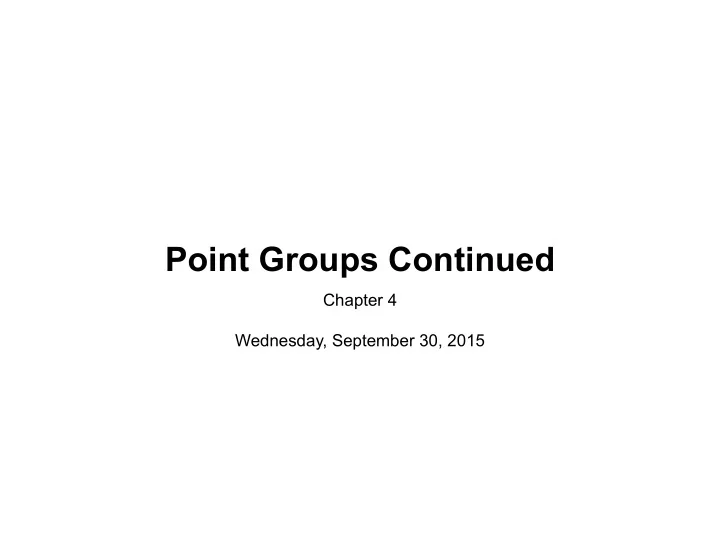

Point Groups Continued Chapter 4 Wednesday, September 30, 2015
Identifying Point Groups The point group of an object or molecule can be determined by following this decision tree: See p. 81, Figure 4.7
Example: phosphorous pentafluoride C 3 C 2 • Does it belong to one of the special low- or high-symmetry point groups? • NO. • Find the principal axis. • Does it have perpendicular C 2 axes? • YES. The principal axis is a C 3 and there are three perpendicular C 2 s. PF 5 must be D 3 , D 3 d , or D 3 h .
Example: phosphorous pentafluoride C 3 C 2 • Does it belong to one of the special low- or high-symmetry point groups? • NO. • Find the principal axis. • Does it have perpendicular C 2 axes? • YES. The principal axis is a C 3 and there are three perpendicular C 2 s. PF 5 must be D 3 , D 3 d , or D 3 h . • Is there a horizontal mirror plane? • YES. The horizontal mirror plane is defined by the phosphorous atom and the three equatorial fluorine atoms. D 3 h { E , 2 C 3 , 3 C 2 , σ h , 2 S 3 , 3σ v }
Example: diborane C 2 • Does it belong to one of the special low- or high-symmetry point groups? • NO. • Find the principal axis. • Does it have perpendicular C 2 axes? • YES. In this case the principal axis as well as the perpendicular axes are all C 2 s. Diborane must be D 2 , D 2 d , or D 2 h .
Example: diborane C 2 • Does it belong to one of the special low- or high-symmetry point groups? • NO. • Find the principal axis. • Does it have perpendicular C 2 axes? • YES. In this case the principal axis as well as the perpendicular axes are all C 2 s. Diborane must be D 2 , D 2 d , or D 2 h . • Is there a horizontal mirror plane? • YES. It turns out that there are three mirror planes. Each one is perpendicular to one C 2 axis. D 2 h { E , C 2 ( z ), C 2 ( y ), C 2 ( x ), i , σ( xy ), σ( xz ), σ( yz )}
Example: 18-crown-6 ether C 6 C 2 ? C 2 ? 1,4,7,10,13,16- hexaoxacyclooctadecane • Does it belong to one of the special low- or high-symmetry point groups? • NO. • Find the principal axis. • Does it have perpendicular C 2 axes? • NO.
Example: 18-crown-6 ether σ v C 6 C 2 ? C 2 ? σ d 1,4,7,10,13,16- hexaoxacyclooctadecane • Does it belong to one of the special low- or high-symmetry point groups? • NO. • Find the principal axis. • Does it have perpendicular C 2 axes? • NO. • Is there a horizontal mirror plane? • NO, but there are vertical and dihedral mirror planes. The vertical mirror planes contain two O atoms and are parallel to the C 6 axis. The dihedral mirror planes bisect opposite C–C bonds and are parallel to the C 6 axis. C 6 v { E , 2 C 6 , 2 C 3 , C 2 , 3σ v , 3σ d }
Self Test Use the decision tree (if needed) to determine the point groups of the following four molecules. D 2d C s C 2h C 4v
Point group of a baseball? D 2d { E , 2 S 4 , C 2 , 2 C 2’ , 2σ d }
Point groups of atomic orbitals? C ∞v D 2h T d
Properties of Mathematical Groups A point group is an example of an algebraic structure called a group, a collection of elements that obey certain algebraic rules. The four key rules that define a group are: 1. Each group contains an identity operation that commutes with all other members of the group and leaves them unchanged (i.e., EA = AE = A ). * 2. Each operation has an inverse operation that yields the identity when multiplied together. For example, in C 3v { E , 2 C 3 , 3σ v }: 2 = E . σ v σ v = E and C 3 C 3 3. The product of any two operations in the group must also be a member of the group. For example, in C 4v { E , 2 C 4 , C 2 , 2σ v , 2σ d }: C 4 C 4 = C 2 , C 4 σ v = σ d , σ d σ v = C 4 , etc. 4. The associative law of multiplication holds, i.e., A ( BC ) = ( AB ) C. *Note that we operate (multiply) from right to left, as with matrices
Recommend
More recommend